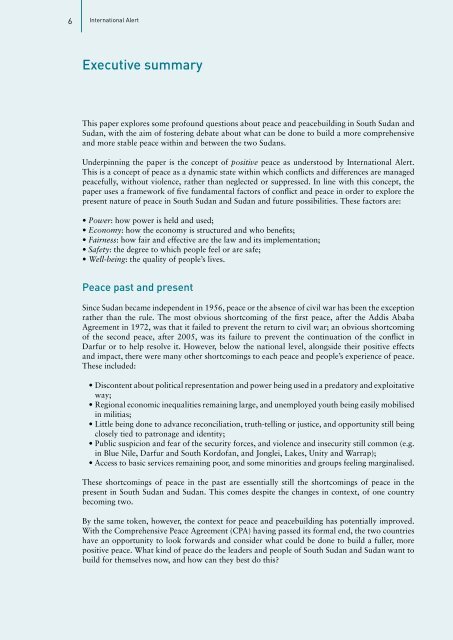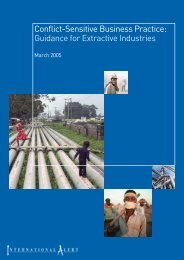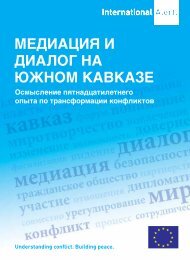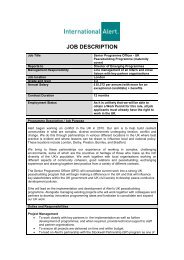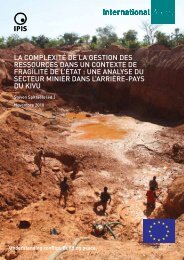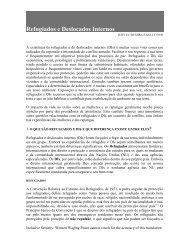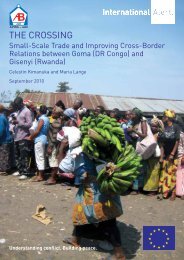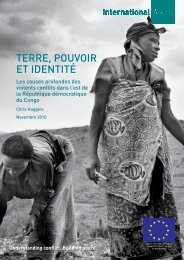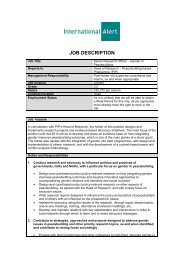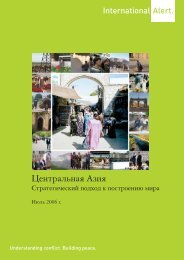6 International AlertExecutive summaryThis paper explores some profound questions about <strong>peace</strong> <strong>and</strong> <strong>peace</strong>building in South Sudan <strong>and</strong>Sudan, with the aim of fostering debate about what can be done to build a more comprehensive<strong>and</strong> more stable <strong>peace</strong> within <strong>and</strong> between the two Sudans.Underpinning the paper is the concept of positive <strong>peace</strong> as understood by International Alert.This is a concept of <strong>peace</strong> as a dynamic state within which conflicts <strong>and</strong> differences are managed<strong>peace</strong>fully, without violence, rather than neglected or suppressed. In line with this concept, thepaper uses a framework of five fundamental factors of conflict <strong>and</strong> <strong>peace</strong> in order to explore thepresent nature of <strong>peace</strong> in South Sudan <strong>and</strong> Sudan <strong>and</strong> future possibilities. These factors are:• Power: how power is held <strong>and</strong> used;• Economy: how the economy is structured <strong>and</strong> who benefits;• Fairness: how fair <strong>and</strong> effective are the law <strong>and</strong> its implementation;• Safety: the degree to which people feel or are safe;• Well-being: the quality of people’s lives.Peace past <strong>and</strong> presentSince Sudan became independent in 1956, <strong>peace</strong> or the absence of civil war has been the exceptionrather than the rule. The most obvious shortcoming of the first <strong>peace</strong>, after the Addis AbabaAgreement in 1972, was that it failed to prevent the return to civil war; an obvious shortcomingof the second <strong>peace</strong>, after 2005, was its failure to prevent the continuation of the conflict inDarfur or to help resolve it. However, below the national level, alongside their positive effects<strong>and</strong> impact, there were many other shortcomings to each <strong>peace</strong> <strong>and</strong> people’s experience of <strong>peace</strong>.These included:• Discontent about political representation <strong>and</strong> power being used in a predatory <strong>and</strong> exploitativeway;• Regional economic inequalities remaining large, <strong>and</strong> unemployed youth being easily mobilisedin militias;• Little being done to advance reconciliation, truth-telling or justice, <strong>and</strong> opportunity still beingclosely tied to patronage <strong>and</strong> identity;• Public suspicion <strong>and</strong> fear of the security forces, <strong>and</strong> violence <strong>and</strong> insecurity still common (e.g.in Blue Nile, Darfur <strong>and</strong> South Kordofan, <strong>and</strong> Jonglei, Lakes, Unity <strong>and</strong> Warrap);• Access to basic services remaining poor, <strong>and</strong> some minorities <strong>and</strong> groups feeling marginalised.These shortcomings of <strong>peace</strong> in the past are essentially still the shortcomings of <strong>peace</strong> in thepresent in South Sudan <strong>and</strong> Sudan. This comes despite the changes in context, of one countrybecoming two.By the same token, however, the context for <strong>peace</strong> <strong>and</strong> <strong>peace</strong>building has potentially improved.With the Comprehensive Peace Agreement (CPA) having passed its formal end, the two countrieshave an opportunity to look forwards <strong>and</strong> consider what could be done to build a fuller, morepositive <strong>peace</strong>. <strong>What</strong> kind of <strong>peace</strong> do the leaders <strong>and</strong> people of South Sudan <strong>and</strong> Sudan want tobuild for themselves now, <strong>and</strong> how can they best do this?
<strong>What</strong> <strong>peace</strong> <strong>and</strong> whose?7Future <strong>peace</strong>A key step, <strong>and</strong> a change from the way about which <strong>peace</strong> has traditionally been thought in bothSudan <strong>and</strong> South Sudan, would be to develop a process of discussion, or “visioning”, aboutvisions for future <strong>peace</strong> in each country <strong>and</strong> what a shared vision of <strong>peace</strong> would be. A visioningprocess can give people an opportunity to overcome the political factors which constrain theirability to find <strong>peace</strong>ful solutions to today’s problems. It can also help to build consensus about<strong>and</strong> support for addressing underlying issues <strong>and</strong> factors of conflict which otherwise may continueto go unaddressed. In developing a shared vision for <strong>peace</strong>, it can be helpful to ask questions <strong>and</strong>to identify some principles for <strong>peace</strong>building; for example, who is responsible for <strong>peace</strong> in SouthSudan <strong>and</strong> Sudan, <strong>and</strong> who needs to be involved for a deeper, more stable <strong>peace</strong> to be built?Answers to these questions should come first <strong>and</strong> foremost from within South Sudan <strong>and</strong> Sudan,for example as part of dialogue <strong>and</strong> discussion which leads to a statement of principles for<strong>peace</strong>building. Considering the history <strong>and</strong> recent experience of <strong>peace</strong> in South Sudan <strong>and</strong> Sudan– <strong>and</strong> the shortcomings of <strong>peace</strong> today – some principles for future <strong>peace</strong> in the two countriesare surely key. Firstly, <strong>peace</strong> in each country should be for all, not just a minority or a majority.Secondly, <strong>peace</strong> <strong>and</strong> <strong>peace</strong>building are important not only within each country, but also betweenthe two. Lastly, <strong>peace</strong>building should encourage change. This may be the most difficult principleor idea for parties in South Sudan <strong>and</strong> Sudan to accept, <strong>and</strong> still more difficult to put into practice.However, to build a more comprehensive <strong>and</strong> more stable <strong>peace</strong> entails changes: changes in goals,changes in how the issues which cause conflict <strong>and</strong> prevent a more complete <strong>peace</strong> are addressed,<strong>and</strong> changes in behaviour <strong>and</strong> action.Conclusions <strong>and</strong> recommendationsThe paper concludes by making three broad recommendations to those in South Sudan <strong>and</strong> Sudanwho are concerned to build a more comprehensive <strong>and</strong> more stable <strong>peace</strong>, <strong>and</strong> to those in theinternational community who are concerned to support their efforts. These are:• Use a positive <strong>peace</strong> framework to define goals <strong>and</strong> measure progress. To be successful,<strong>peace</strong>building should use a framework of positive <strong>peace</strong>, which will highlight what changesin institutions, attitudes <strong>and</strong> behaviours will bring about a stronger <strong>and</strong> more comprehensive<strong>peace</strong>, rather than simply containing the conflicts of today.• Promote a visioning <strong>and</strong> sustained dialogue process about <strong>peace</strong>. A sustained <strong>and</strong> inclusiveprocess of dialogue, framed around developing a broadly shared vision or set of visions forlong-term <strong>peace</strong>, could build consensus <strong>and</strong> support for addressing the factors of conflictwhich otherwise go unaddressed.• Dialogue <strong>and</strong> advocacy to identify how the economy can best support long-term <strong>peace</strong>. Theeconomic dimension of <strong>peace</strong> has long been neglected. By combining research, discussion <strong>and</strong>advocacy on key economic sectors such as infrastructure, l<strong>and</strong> <strong>and</strong> oil, or cross-cutting issuessuch as corruption, equity, <strong>and</strong> cross-border trade, it should be possible to develop a processwhich leads to positive change in economic governance in South Sudan <strong>and</strong> Sudan – changewhich is beneficial to all parties <strong>and</strong> which reduces the risk <strong>and</strong> incidence of conflict.


